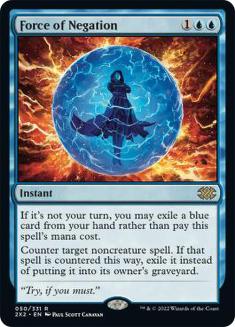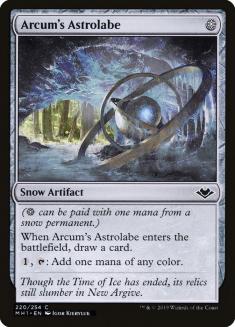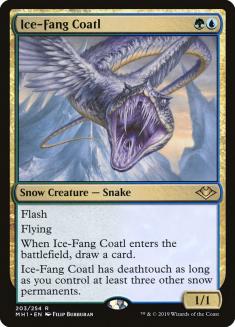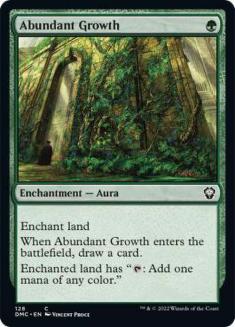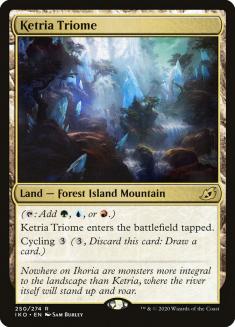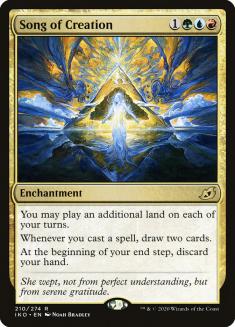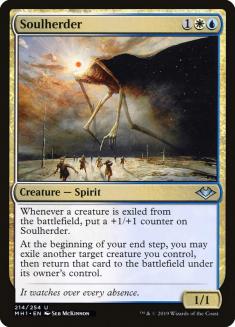Constructed Magic in 2020 is a retelling of a story as old as time — a Cat trying to catch a Bird. Lurrus of the Dream-Den has marked its territory in Magic’s oldest and most powerful formats, dominating every Legacy and Vintage tournament for the past month on Magic Online. Yorion, Sky Nomad has made its nest in Ikoria Standard, where 60-card decks are quickly becoming the exception. The formats in between are more contested — the question isn’t whether one of them is the best thing you can do, but which one.
Lurrus seemed poised to win that race in Modern, reviving old favorites like Jund and Grixis Delver and giving aggressive strategies like Boros Burn, Boros Prowess, and Selesnya Hexproof a way to rebuild or press their advantage in the mid-game at zero cost. When Lurrus did force players to make sacrifices, it often made their decks better anyway — who needs Bloodbraid Elf when you have a cheaper way to accomplish its goals that already leaves you up a card before it arrives?
This sets the bar high for Yorion, which imposes a much steeper deckbuilding cost — not just any cost at all but one that challenges assumptions that have defined Magic for decades. Thankfully, there are good theoretical and practical reasons to expect Yorion to hold its own. As Sam Black highlighted in his preview for Yorion, the idea of playing more than 60 cards is an unexplored (well, not by him…) but promising space in formats with fetchlands.
This was a riskier proposition in Legacy and Vintage where Force of Will is a crucial safety valve against fast combo decks (though the idea of either format as a war zone where you’re likely to lose before taking a turn was always an exaggeration and has never been less true). Force of Negation added the necessary redundancy to this effect — while making it less necessary by pushing less resilient combo decks out of the format — and Legacy has seen Yorion lift Azorius Miracles and Sultai Control to new heights. Yorion’s companion constraint remains a tough sell in Vintage, where the burden of proof for any expensive spell is much higher and you want to draw the restricted cards that fill out every blue deck as often as possible.
Modern has crucial differences from its older cousins that make Yorion — and the larger decks that come with it — more appealing. Across seventeen years of sets there are enough cheap versions of any basic ingredient that you can ensure you have these reliably even in a larger deck. Crucially, the pace of the format lets you look higher up the curve for this redundancy — only Force of Negation is a Force of Negation but Mana Leak can be Drown in the Loch or Remand or Deprive as required. In the interactive decks most interested in Yorion, no one card is worth that much more than any other — there’s nothing like Ancestral Recall or Black Lotus where drawing it a bit less often is worth never drawing a companion.
Years ago, Modern’s detractors would cite the weakness of traditional reactive strategies and the importance of sideboard cards in beating linear decks — you would bet on the player casting Stony Silence against a Mox Opal deck, even knowing nothing else about the players, decks, or game state. The sequential removal of Faithless Looting, Mox Opal, and Once Upon a Time hobbled a wide swathe of Modern’s linear decks and narrowed the range of opponents that have to be targeted in sideboarding, lessening reliance on any one hate card. Meanwhile, the “fair” side of Modern picked up the best tools it’s ever had — Simic-based control built around Uro, Titan of Nature’s Wrath and Mystic Sanctuary emerged as a dominant force before Ikoria: Lair of Behemoths and is a natural home for Yorion:
Creatures (10)
Planeswalkers (9)
Lands (30)
Spells (31)

Creatures (9)
Planeswalkers (4)
Lands (33)
Spells (34)

The conversation around Yorion would have been totally different a year ago. Some big hitters from the last year paved the way for Modern’s biggest Bird:
When we look back from our rocking chairs on the Magic history that’s still being written, Arcum’s Astrolabe may prove to be the most impactful card in Modern Horizons. On top of burying everyone’s favourite basic lands in a nondescript tundra, Astrolabe has removed the implicit challenges in constructing a manabase in a way not seen since Vivid Creek and Reflecting Pool let you pair Cruel Ultimatum and Cloudthresher with a side of Wrath of God — it’s remarkable that playing Blood Moon in your five-colour Cryptic Command deck is unremarkable.
The innocuous snow globe is so important that we turn to Abundant Growth as a reasonable imitation that probably should have seen more play pre-Yorion:
This freedom to explore the colour pie opens up a new form of redundancy — we don’t need to debate the best backup for Path to Exile in white when we can turn to Lightning Bolt and Fatal Push instead. Astrolabe and Growth not only acknowledge Yorion’s cost but unlock its potential. With the help of Ice-Fang Coatl — less useful as a removal spell than it used to be but perfectly fine as an early play in a reactive strategy — Yorion is at worst a giant Mulldrifter in most games. This package slots neatly into an 80-card deck and demands no real commitment.
Yorion preemptively mitigates a less obvious downside of loading up on these cantrips. Though having cheap cards that replace themselves lets you shave lands, Astrolabe and Growth encourage more adventurous manabases that need a minimum amount of lands to function properly. These cantrips occupy slots reserved for spells and artificially inflate the amount of lands in your deck — the Boros Cycling decks in Ikoria Draft run a historically low land count and their Standard counterparts run as few as they can but both are still prone to flooding.
This math changes as the deck size increases — a Battle of Wits deck with an equivalent ratio of lands, spells, and “cyclers” will draw a spell slightly more often — but the extra twenty cards from Yorion barely move this needle. These cantrips are not frictionless, as spending a mana you can’t spare to find a new card can cost you the game against Modern’s faster decks. Thankfully, the presence of Yorion as a companion gives you a guaranteed high-impact spell that finds even more cards and rewards you for making land drops. These decks also feature individually powerful cards like Uro and Cryptic Command that are worth the risk of flooding and still replace themselves.
Fans of this style of deck are spoiled for choice. Each combination of colours offers a different suite of tools.
Red:
- Lightning Bolt is still a marquee removal spell in a format where Monastery Swiftspear is the most popular threat but poor against the Tarmogoyfs popping up in response. There are few planeswalkers around that Bolt cleanly removes. Mystic Sanctuary with Bolt is a surprisingly potent kind of reach but the deck doesn’t apply enough pressure to make that relevant early.
- Wrenn and Six is outstanding in pseudo-mirrors as a threat that’s hard to remove and easy to defend, a source of card advantage, and a way to guarantee the control mirror goal of making land drops. Recurring fetchlands is a useful form of fixing as you can dip into red knowing that Wrenn will let you pivot to other colours. The format at large has few X/1 creatures that you’re eager to shoot with Wrenn.
- Blood Moon is lights out against specifically Amulet Titan and can steal games elsewhere but can be a double-edged sword and is not always castable early enough to lock out opponents with similarly flimsy manabases.
- Anger of the Gods is excellent against Lurrus aggro where three mana is a lot less than four and exiling creatures stops Lurrus presenting a second wave.
Black:
- Fatal Push is at its best when Lurrus forces its decks to lower their curve and there are few creatures that avoid Push other than Yorion itself.
- Abrupt Decay, Assassin’s Trophy, and Drown in the Loch give the Sultai base the most flexible, cheap interaction. Notably, Trophy hitting lands is more important now that Field of Ruin is harder to support.
- Unmoored Ego is a fine catch-all against big mana and combo hoping to race aggro decks; at the time of writing, Mono-Green Tron, Ad Nauseam, and Neoform were first, second, and third in the most recent Modern Challenge on Magic Online.
- Thoughtseize and Inquisition of Kozilek offer a new type of interaction but the classic tension between discard spells and reactive cards is still present and having to fetch a black source on Turn 1 is a problem.
White:
- Path to Exile is good on paper against Lurrus decks but Lurrus makes them better at using extra mana and you need your removal spells to be online early against Burn or Prowess.
- Teferi, Time Raveler is the best card against other blue decks and its floor is decently high if you have time. This Teferi is naturally strong in a Yorion deck as they both look for permanents with enters-the-battlefield effects.
- Supreme Verdict has a marginal upside over Wrath of God as a blue card for Force of Negation but the creature decks in 2020 Modern aren’t trying to counter your spells.
Multicolour:
- Lightning Helix remains the best card against Burn and Prowess, which is more important than ever right now, but is considerably worse here than in Jeskai as accessing two “splash” colours requires either time or life loss that you won’t always have and can leave you unable to cast other spells.
- Kaya’s Guile is fine against aggro (the sacrifice effect is vital against Selesnya Hexproof, a popular choice to exploit the red decks) though it shares the mana problems of Lightning Helix. Any removal spell will be lackluster against control but exiling graveyards helps you fight Uro and Mystic Sanctuary.
This shell was arguably the best deck in Modern before Ikoria and has only become stronger with the help of Yorion. The colours and cast of characters may change but 80 of these cards are sure to be a good choice.
Creatures (10)
Planeswalkers (2)
Lands (36)
Spells (32)

Scapeshift has been a fixture of the format since its former life as Extended. Previous iterations leaned more heavily on their namesake, using setup cards like Peer Through Depths to chase their big finish. Uro, Yorion, and the Cryptic Command loop with Mystic Sanctuary all contribute to a more well-rounded combo-control deck. Unlike other Mystic Sanctuary decks, Temur Scapeshift boasts a game-winning instant or sorcery that the on-demand recursion can force through counters or discard.
The Ikoria Triomes are ideal for Scapeshift, boosting fetchlands, Mystic Sanctuary, and Valakut, the Molten Pinnacle — a Simic manabase with a stack of Mountains is never pretty but Ketria Triome offers solid fixing and flood insurance. As with Sanctuary, the four-colour and five-colour decks enjoy the option of fetching a three-colour land but rarely want to draw a land that always enters the battlefield tapped — a larger deck is a benefit here as you draw the Triome or Sanctuary less often but still have consistent access via a dozen or more blue fetchlands.
Simic Uroza was another contender for the throne pre-Ikoria and successfully adapted to this 80-card world. I thought it looked incoherent and disjointed even before it had to fill another twenty slots but I missed the point – it may be a bad deck for Urza, a bad deck for Emry, and a bad deck for Uro, but each of those legendary creatures is strong enough to carry their weight even when they can’t realize their full potential, and having so many premier threats alongside Yorion means that you always have a powerful plan to work towards.
Urza, Lord High Artificer is a proven superstar in its own right and even better with a companion. Urza makes enough mana to pay for Yorion and creates another Construct when blinked. Any blinked artifacts return untapped to generate more mana for instants or an Urza activation on the opponent’s turn.
This new twist on Uroza has earned respect but an experimental list from a Magic Online Super Qualifier is even more eye-catching:
Creatures (26)
- 3 Wall of Blossoms
- 4 Ice-Fang Coatl
- 4 Urza, Lord High Artificer
- 4 Gilded Goose
- 4 Emry, Lurker of the Loch
- 4 Uro, Titan of Nature's Wrath
- 3 Kinnan, Bonder Prodigy
Lands (28)
Spells (26)

Urza promises a substantial return on a demanding sticker price so this list features many more ways to jump to four mana. Springleaf Drum couples up with the plethora of cheap creatures — including 1990s workhorse Wall of Blossoms! — and Kinnan, Bonder Prodigy turns Drum, Gilded Goose, and Arcum’s Astrolabe into new, shiny Sol Rings. Mox Amber, a surprising omission from this list, is a perfect partner for Kinnan and Emry, Lurker of the Loch.
Song of Creation made a lot of noise during preview season but the combo-centric Song lists haven’t yet made their mark. Here it’s a mid-game engine that benefits from the deck’s low curve and Urza allowing cheap artifacts to effectively pay for themselves. Its synergy with Yorion is less obvious than most but no less powerful — blinking Song lets you avoid the discard trigger, letting you use all the cards drawn in the first Song turn to set up a ridiculous second Song turn. Activating Emry or escaping Uro offers a spell in reserve outside the hand to start a Song chain.
Several fringe Modern decks were designed around blinking permanents. Could Yorion revive them too?
Creatures (11)
Planeswalkers (9)
Lands (31)
Spells (29)

A lot has changed since Ben Friedman anointed Jeskai Saheeli the best deck in Modern, but that includes the arrival of a companion tailor-made for the strategy. Saheeli Rai and Felidar Guardian share Yorion’s desire for permanent cantrips and both can send it on a wild goose chase – Felidar Guardian sets up a loop on each player’s turn, while Saheeli Rai can copy Yorion and have the copy blink the original for another round of triggers (including a reset for Saheeli, ready to -3 again next turn).
Spreading Seas is oddly powerful against the aggro decks as they aim to use their coloured mana on one-drops every turn, making it the best land destruction spell in Modern. Blood Moon joins Seas as a one-two punch for big mana matchups that can punish anyone relying a little too much on Arcum’s Astrolabe to tie the room together.
Creatures (34)
- 1 Eternal Witness
- 4 Coiling Oracle
- 3 Venser, Shaper Savant
- 4 Noble Hierarch
- 3 Restoration Angel
- 4 Reflector Mage
- 4 Ice-Fang Coatl
- 4 Soulherder
- 4 Gilded Goose
- 3 Charming Prince
Lands (32)
Spells (14)

Yorion is an easy sell for anyone registering Ephemerate. This deck was already a player in Modern’s minor leagues and now looks like a thought experiment designed to push Yorion as far as possible.
Trying to Ephemerate a fragile creature looks ambitious in a format full of cheap removal but the creatures you want to blink all blunt removal by leaving something behind. Soulherder makes you more susceptible to immediate interaction but gets you at least one card back if it survives the turn and then runs away with the game. Pairing Soulherder with Reflector Mage or Venser, Shaper Savant locks up the battlefield and it quickly outsizes anything lucky enough to remain there. Yorion makes Soulherder a lethal threat while setting up the loops that are already all too familiar.
After less than a month Yorion’s talons are so deeply embedded in Constructed Magic that this kind of study is possible for every major format. Running 80 cards is normal now. Modern is not the exception that proves the rule – it just proves the rule.


